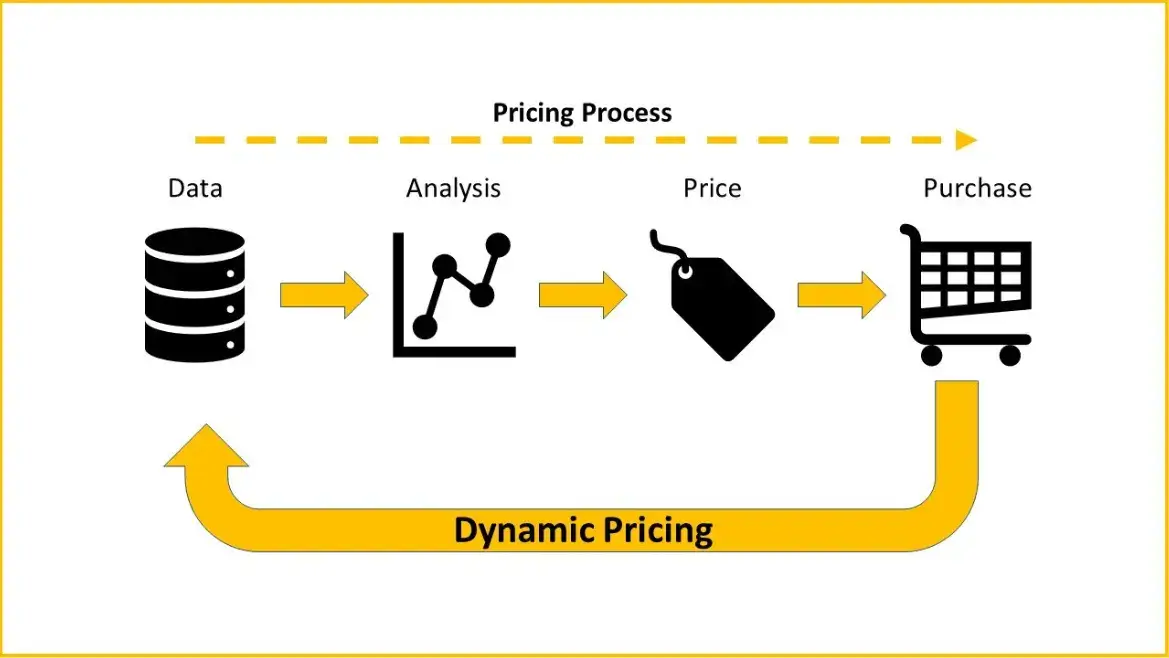Let's paint a picture. You've worked tirelessly to create an online course. The content is polished, the videos are engaging, you've used a professional certificate maker to create course completion awards, and the platform is user-friendly. But then comes the tricky part — setting the price.
You've probably asked yourself, "How much should I charge?” “Should the price vary?” “How do I ensure the course remains accessible while maximizing revenue?”
Enter the fascinating world of dynamic pricing. This strategy, backed by the power of artificial intelligence, is your game-changer.
Skip to:
- What is Dynamic Pricing?
- How Can AI Help With Pricing Strategies?
- Tip 1: Implement Real-Time Price Adjustments
- Tip 2: Analyze Customer Behavior with AI
- Tip 3: Create Personalized Pricing Models
- Tip 4: Offer Time-Sensitive Discounts
- Tip 5: Integrate Dynamic Pricing with Email Marketing

Custom image created in Canva
What Is Dynamic Pricing?
We all know that nobody wants to work for free. Dynamic pricing, in simple terms, is changing prices in real-time or near-real-time based on various factors.
Think of airline tickets or ride-sharing services; the prices fluctuate based on demand, time, and sometimes even the weather.
But how does this relate to your online courses? Dynamic pricing can help you optimize your revenue by charging the right price at the right time.
It's about finding that sweet spot where your potential customers see the value, and you see a profit.
How Can AI Help With Pricing Strategies?
Now, why are we bringing AI into this? You see, dynamic pricing isn't just about randomly changing prices. It's a fine art backed by data and analysis.
AI has the remarkable ability to analyze vast amounts of information in the blink of an eye.
AI can track your potential customers' behavior, monitor competitors' pricing, analyze market trends, and predict future demand.
Imagine having all this intelligence at your fingertips, guiding your pricing strategy. That's what AI brings to the table.
So, let's explore five actionable tips that will help you master dynamic pricing and take your online course revenue to new heights.
Whether you're a solopreneur, a small business owner, or an eCommerce enthusiast, these insights are tailored just for you.
Are you ready? Let's get started!
Tip 1: Implement Real-Time Price Adjustments

In the world of online course selling, market dynamics change rapidly. Seasonal trends, competitor actions, customer demands, and even global events can influence the value perception of your e-learning courses.
Implementing real-time price adjustments ensures that your pricing strategy remains relevant and competitive at any given moment.
Before diving into real-time adjustments, you must identify the factors triggering these changes.
Are you considering demand fluctuations, competitor pricing, time of day, geographic location, or a combination? Understanding these factors will guide your dynamic pricing model.
Your choice of platform affects pricing—premium options like Podia support higher prices with better features and credibility, while budget alternatives to Podia may require lower pricing due to limited tools and flexibility.
-
Set price boundaries
While flexibility is critical, it doesn’t mean that prices should swing wildly. Define the upper and lower limits for course prices to maintain profitability and avoid surprising customers with extreme price changes.
-
Monitor competitor behavior
Real-time adjustments must consider the competitive landscape. Continuously monitoring what competitors charge for similar courses will allow your AI algorithms to respond accordingly, ensuring your prices align with the market.
-
Test and learn
Implementing real-time price adjustments is not a one-off task. You should continually test different pricing strategies, analyze the results, and adjust your approach.
AI can help run these experiments and learn from the data, but human insights are crucial for interpreting the results and making strategic decisions.
-
Analyze and iterate
The work doesn’t stop once you've implemented real-time adjustments.
Regularly analyze how your pricing strategy is performing. Are you attracting more customers? Are your revenue and profitability increasing?
Keep iterating on your strategy, making improvements based on data and customer feedback.
Implementing real-time price adjustments is like tapping into the heartbeat of the market. You can feel the rhythm, understand the pulse, and react accordingly.
It requires technology, strategy, careful planning, and continuous learning. However, the rewards for optimized revenue and increased accessibility to your courses can be significant.
Tip #2: Analyze Customer Behavior with AI

Custom image created in Canva
Understanding customer behavior is vital for any business, especially those selling online courses. Why?
Because every click, view, and purchase tells a story about what your customers need, want, and expect from your courses.
Analyzing these behaviors with AI can give you unprecedented insights and help you make intelligent pricing decisions.
Let’s begin by breaking down the customer journey.
- Discovery: How do customers find your courses? What channels drive them to your site? Understanding this stage can help you price competitively and place your courses in the right places.
- Consideration: What factors do customers weigh when considering your courses? Reviews, comparisons, demos, and prices are all variables that can influence their decision-making. Tailor your pricing strategy to meet these specific needs.
- Purchase: What finally convinces a customer to make a purchase? Is it a limited-time offer, a bundle, or something else? Analyzing this stage will help you implement dynamic pricing that resonates with your customers at the moment of decision.
- Retention: How do you keep customers coming back for more? Analyzing their post-purchase behavior and feedback can guide your ongoing pricing strategies, helping you offer returning customers valuable deals.
Next, use AI Algorithms.
AI isn’t just a buzzword; it’s a tool that can sift through massive amounts of data to recognize patterns that might be invisible to the human eye.
Using this machine learning course and predictive analytics, AI can help you understand:
- Personal preferences: What specific features or content attract individual customers?
- Seasonal trends: Are there times of the year when specific courses sell better?
- Price sensitivity: How do customers react to different price points, discounts, or offers?
Once you understand your customer's behavior, you can offer personalized pricing.
You could offer a discount on a course bundle to a customer who's completed a related course, or you could provide exclusive early access to new courses for your most loyal customers.
The possibilities are endless, but they all start with understanding. Now, measure, adjust, and repeat.
AI-driven analysis of customer behavior isn't a set-and-forget strategy. Continuously measure how your pricing changes are performing, adjust based on new insights, and repeat the process.
Stay agile and willing to evolve as you learn more about your customers.
Analyzing customer behavior with AI is like having a magnifying glass that reveals the intricacies of your customer's journey. It shows you what they love, what they ignore, what makes them click "buy," and what keeps them coming back.
The insights gleaned from AI can inform your pricing and marketing, product development, and customer service strategies.
It's a holistic approach that places your customer at the center, continually asking, "What do they need, and how can we provide it?"
Tip #3: Create Personalized Pricing Models

Personalized pricing is all about finding the sweet spot between what your online courses are worth and what your specific audience is willing to pay. It’s not a one-size-fits-all approach.
Instead, it caters to different segments of your customer base, recognizing that value may vary from one person to the next.
Importance of personalization
Personalized pricing isn’t just a fancy trick; it’s a powerful tool that can boost your revenue, increase conversions, and improve customer satisfaction. Here's why:
- Increased engagement: Customers feel valued when you offer them something unique.
- Higher conversions: Tailored offers can hit home more effectively.
- Customer loyalty: Show that you understand and appreciate your customers, and they’ll stick around.
5 steps to create personalized pricing models
- Segment your audience: Divide your customers into different segments based on their behavior, preferences, or demographics. Consider what differentiates one group from another and how those differences might impact their willingness to pay.
- Analyze the data: Use AI and data analytics to understand each segment's values. Do they prefer video content over written materials? Are they more interested in short courses or comprehensive programs?
- Set goals: What do you want to achieve with personalized pricing? More sales, higher engagement, increased loyalty? Knowing your goals will guide your strategy.
- Develop pricing strategies: Create different pricing models for each segment. It might include bundling, discounts for bulk purchases, membership pricing, or exclusive offers.
- Scale carefully: Personalization can be complex. Start small, prove the concept, and then scale as you learn what works for your audience.
Examples of personalized pricing
- Early bird offers: Offer discounts for those who enroll in a course before a specific date.
- Loyalty discounts: Provide special pricing for repeat customers or those who refer others.
- Location-based pricing: Adjust pricing based on geographic locations, reflecting the varying economic conditions.
Personalized pricing places your customers at the heart of your business. By understanding their unique needs and preferences, you can create pricing models that resonate on a personal level.
Tip #4: Offer Time-Sensitive Discounts

Time-sensitive discounts, often called "flash sales" or "limited-time offers," create a sense of urgency that encourages potential customers to act quickly.
They see a fantastic deal, realize it won't last forever, and boom! That push is often all they need to click "buy."
Why offer time-sensitive discounts?
- To boost sales quickly: Need to hit a target or move a specific product? A flash sale can do wonders.
- To attract new customers: People love a good deal, and a time-sensitive discount can pull in folks who might not otherwise give your courses a second glance.
- To reward loyal customers: Offering exclusive, time-limited discounts to existing customers can increase loyalty and satisfaction.
- To clear out inventory: If you want to replace an old course with a new version, a quick discount can help you make room.
Steps to create successful time-sensitive discounts
- Identify your target: What's the purpose of your sale? Whether it's attracting new customers, boosting a specific course, or rewarding loyalty, knowing your goal will shape your strategy.
- Choose the right time: Think seasonally. Offering a discount on a summer course in winter might not make sense. Analyze customer behavior and choose the timing that fits your audience best.
- Set clear terms: How long will the discount last? What courses does it apply to? The more precise you are, the more clarity there will be.
- Promote effectively: Use social media, email marketing, and your website to inform people about the sale. But remember, it's time-sensitive, so start early enough. Platforms such as Hootsuite or one of its alternatives make it much easier for small businesses to engage their prospective customers on social media.
- Use AI to analyze success: Implement AI algorithms to track how your time-sensitive discounts are performing. This way, you can make data-driven decisions and optimize future campaigns.
- Create a sense of scarcity: Emphasize the limited nature of the offer. Show a countdown timer or mention how many seats are left at the discounted price.
- Ensure a smooth checkout process: The last thing you want is customers to get frustrated and abandon their cart. Ensure your website is optimized and can handle the increased traffic and that the checkout process is seamless.
Examples of time-sensitive discounts
- Weekend sales: Offer a special price for enrollments made during the weekend.
- Holiday promotions: Tap into major holidays like Black Friday or New Year's to provide exclusive discounts.
- Last-minute deals: If a course is about to start and you still have slots to fill, offer a quick, hefty discount to seal the deal.
Tip #5: Integrate Dynamic Pricing with Email Marketing

Email marketing and dynamic pricing are like peanut butter and jelly — they might seem different, but they create something genuinely delectable when combined.
By integrating dynamic pricing with email marketing, you're not just promoting your courses; you're reaching out with personalized, timely offers that meet individual needs and want.
Benefits of integrating dynamic pricing with email marketing
- Personalization: By linking dynamic pricing to email marketing, you can send tailored offers that reflect a subscriber's interests, previous purchases, or browsing behavior.
- Timely Engagement: You can set up automated emails to go out when a price drops, you launch a new course, or when a time-sensitive discount is available.
- Enhanced Conversion Rates: Dynamic and targeted offers can lead to higher click-through rates and conversions.
- Building Relationships: Regular, personalized communication can strengthen customer relationships, turning one-time buyers into loyal fans.
Strategies for successful integration
- Segment Your Audience: Use AI algorithms to segment your email list based on behavior, interests, and previous interactions with your courses. Tailor your dynamic pricing offers accordingly.
- Create Trigger-Based Campaigns: Set up automated emails triggered by specific actions like visiting a particular course page, abandoning a cart, or a price change on a watched course.
- Offer Exclusive Deals: Use email marketing to provide unique discounts or offers that aren't available elsewhere, adding value to being a subscriber to your list.
- Test and Analyze: Implement A/B testing to understand what works best for your audience. Utilize AI-driven analytics to evaluate the performance of different email campaigns.
- Design Responsive Emails: Ensure your emails are well-designed and mobile-friendly, as many users will open them on various devices.
- Integrate with Other Tools: Utilize a CRM, marketing automation tools, and AI algorithms to facilitate smooth integration of dynamic pricing within your email campaigns.
- Follow Up Thoughtfully: If a subscriber shows interest but doesn't bite, don't hesitate to send a gentle reminder or a different offer. But don't overdo it — nobody likes spam.
Practical examples of dynamic pricing
- Early Bird Offers: Email previous course attendees with an exclusive early-bird discount for your next course.
- Abandoned Cart Recovery: If a subscriber leaves a course in their cart without purchasing, send a follow-up email with a special offer.
- Seasonal Promotions: Offer seasonal or holiday-related discounts through email marketing, linking them to your dynamically priced courses.
Think of it this way: your audience is waiting, and with the right blend of dynamic pricing and email marketing, you can reach them in ways you never thought possible.
In Conclusion
Let's take a moment and think beyond the tools and the tech. At its core, this is about you and your passion.
You've worked hard to create something valuable, and these strategies are about getting your work into the hands of those who need it most.
And these strategies? They're not just about numbers and algorithms. They're about understanding, connecting, and building relationships with actual human beings—your students.
The ones who will log in late at night after work, early in the morning before the kids wake up, or during their lunch breaks, all because they believe in what you offer. They believe in you.
Remember that dynamic pricing and AI are just tools in your toolbox. They're here to help you, not define you.
Your creativity, your expertise, and your ability to connect with your

